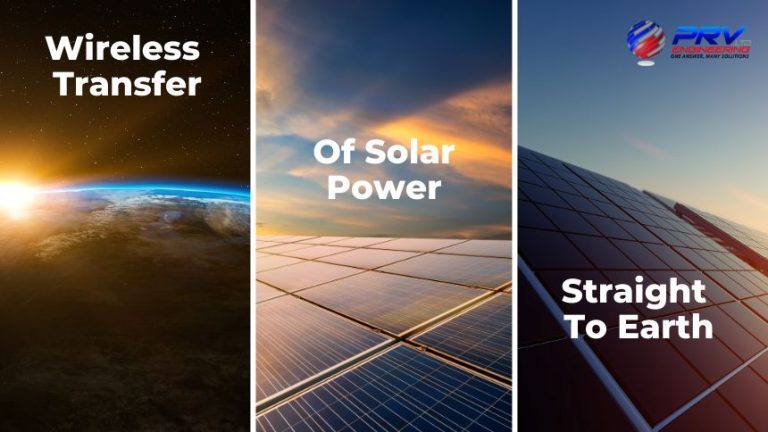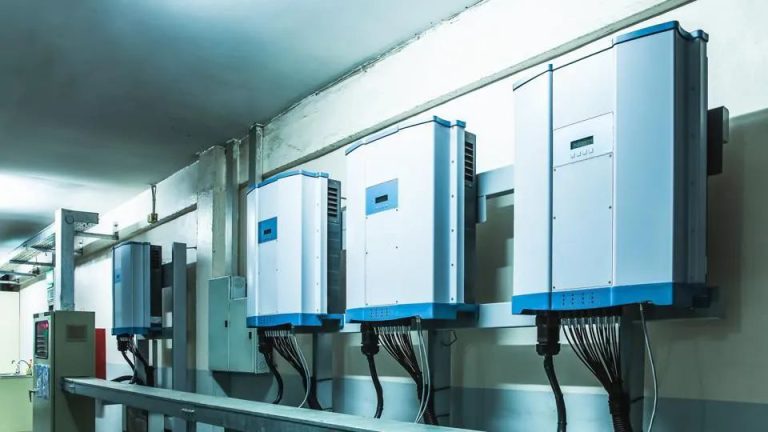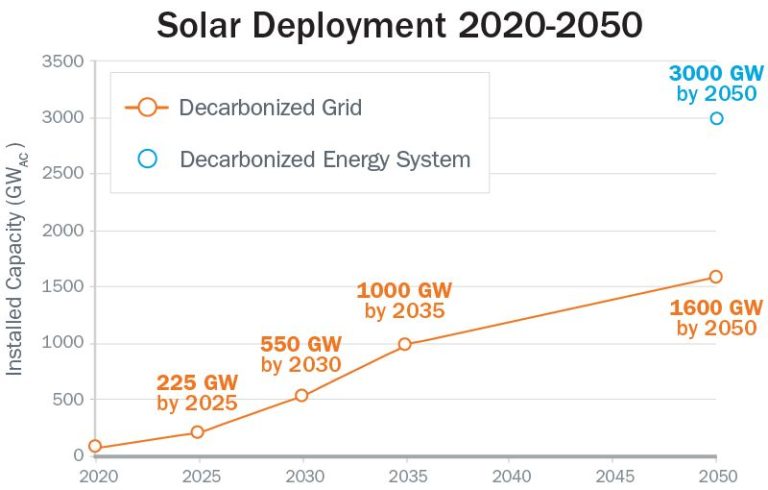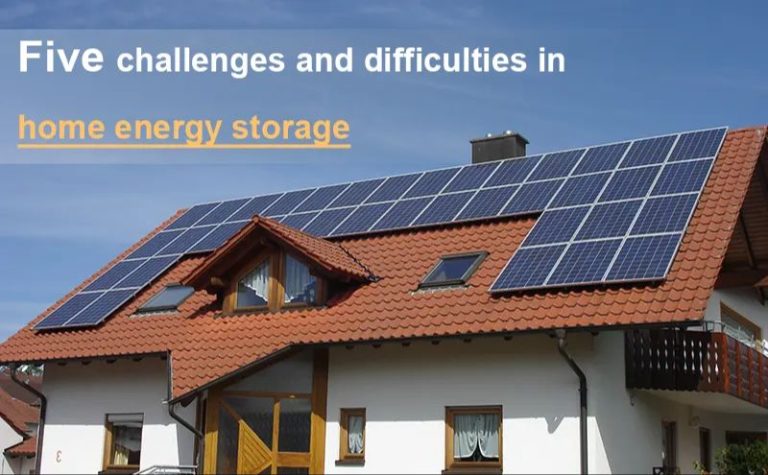Which Is Cheaper Nuclear Or Solar?
Nuclear and solar power are two major sources of carbon-free electricity generation. Nuclear power relies on nuclear fission reactions in a reactor to produce heat and spin a turbine. Solar power converts energy from the sun into electricity using photovoltaic panels or concentrated solar plants. Both have advantages and disadvantages in terms of costs, safety, environmental impact, and scalability.
This article provides a comprehensive comparison of the costs of nuclear versus solar power. Key factors examined include capital costs, fuel costs, operating and maintenance costs, waste disposal, decommissioning costs, government subsidies, and cost per kilowatt-hour (kWh). Environmental externalities are also analyzed. The goal is to objectively compare the economic and environmental profiles of these two major carbon-free energy sources.
Capital Costs
The upfront capital costs to build nuclear power plants are significantly higher than solar power plants. According to Energysage, the cost per kilowatt (KW) for utility-scale solar power is less than $1,000, while the comparable cost per KW for nuclear power is between $6,500-$12,250 [1]. A report by Solarfeeds found the Vogtle nuclear plant in Georgia will cost about $10,030 per KW, almost 10 times more than utility-scale solar [2]. The high nuclear costs are largely due to strict safety requirements and long construction timeframes. Solar panels can be installed relatively quickly in a modular fashion.
Fuel Costs
One of the major differences between nuclear and solar energy is that nuclear requires ongoing fuel costs due to the need for uranium, while solar does not require any fuel after installation. According to Energysage, the cost of uranium accounts for 30-40% of the operating costs of a nuclear reactor.
Uranium prices fluctuate, but as of 2020 were around $30 per pound according to the U.S. Energy Information Administration. A typical 1,000 megawatt nuclear reactor requires around 400,000 pounds of uranium fuel per year. So at current prices, fuel costs for a nuclear plant would amount to around $12 million per year.
In contrast, solar panels do not require any fuel to generate electricity from sunlight. This gives solar an advantage over nuclear in that once the upfront system costs are paid off, there are minimal ongoing fuel expenses.
So while nuclear power has relatively low operating costs, the need for continual uranium purchases makes the ongoing costs higher than solar, which has zero fuel cost after installation.
Operating & Maintenance Costs
Nuclear power plants have very high operating and maintenance costs compared to other power plants. These costs include the staffing, maintenance, and repair of complex nuclear components as well as regulatory compliance costs. According to the U.S. Energy Information Administration, operations and maintenance costs for nuclear plants averaged $0.028 per kWh in 2020, which was over 3 times higher than costs for coal plants ($0.008/kWh) and over 7 times higher than natural gas plants ($0.004/kWh) (EIA).
A 2013 study found that maintenance costs for nuclear plants averaged around $8.6 million per year, while coal plants averaged $5.9 million and gas plants only $1.5 million (Bloomberg NEF). Nuclear plants must adhere to strict regulatory requirements for safety and security, such as developing detailed emergency preparedness plans, maintaining robust on-site security forces, and implementing cybersecurity protections. These regulatory costs can add tens of millions of dollars per year in additional operating expenses.
As nuclear plants age, maintenance costs tend to increase to address component aging and obsolete parts. Refurbishment can cost hundreds of millions of dollars. Overall, the high fixed operating costs make nuclear less economically competitive with other power sources.
Waste Disposal Costs
Nuclear power plants produce radioactive waste that must be safely contained, transported, and stored long-term. This represents a significant cost associated with nuclear power.
According to the Congressional Budget Office, the estimated cost for reprocessing and disposing of spent nuclear fuel is $585 per kilogram, with estimates ranging from $274 to $1,010 per kilogram (Congressional Budget Office, 2007). The United States Government Accountability Office estimates that vitrification and disposal of high-level radioactive waste could cost between $21-$37 billion (GAO, 2021).
Managing nuclear waste is a complex, long-term process. The projected total cost for clean-up after the Manhattan Project is over $300 billion, more than the original cost of the nuclear weapons program (Stanford University, 2018). This highlights the significant expenses associated with the safe disposal of nuclear waste over long timescales.
Decommissioning Costs
Decommissioning costs refer to the expenses required to safely shut down and dismantle a power plant at the end of its operating life. This process involves decontaminating the facility, removing radioactive components, and restoring the site.
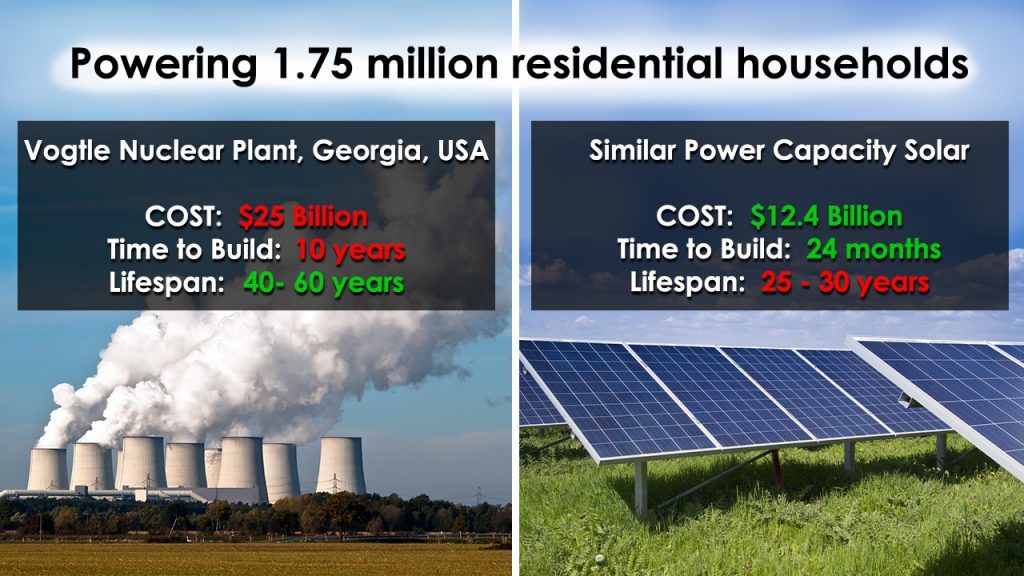
For nuclear power plants, decommissioning costs are substantial, ranging from $300 million to $1 billion per reactor (Nuclear Power Economics | Nuclear Energy Costs). These costs account for about 9-15% of the initial capital costs of building the plant. Decommissioning involves safely removing and disposing of radioactive components, decontaminating the site, and long-term monitoring. It’s a complex process that takes many years and significant funding to complete.
In contrast, decommissioning costs for solar farms are much lower, from $0.03 to $0.20 per watt of capacity (Solar power: decommissioning costs?). Since there are minimal hazardous materials, decommissioning a solar site is simpler. Costs include disassembling racks, panels, and electrical equipment. Some solar components like panels may be resold to offset decommissioning costs.
Overall, the high radioactive waste and contamination associated with nuclear plants makes their decommissioning costs substantially higher than solar farms. These legacy costs are a major economic disadvantage of nuclear power.
Government Subsidies
Both nuclear power and solar power receive government subsidies and incentives, however in recent years solar has received significantly more subsidies in the United States.
According to World Nuclear Association, as of 2021 the US nuclear industry has received about $4.1 billion per year in government subsidies. This includes subsidies for nuclear plant construction, research and development, fuel cycle facilities, and overhead costs. The nuclear industry has argued these are necessary for enhancing safety and developing next generation reactors.
In comparison, analysis by Robert Bryce shows the solar industry received over 300 times more federal subsidies than nuclear in 2021, about $13.7 billion. The solar Investment Tax Credit alone provided over $11 billion in subsidies. With the recently passed Inflation Reduction Act extending solar subsidies through 2032, by 2029 solar could be receiving $10 billion per year in federal subsidies, over 200 times nuclear power.
This massive difference in subsidies provided is a key factor in evaluating the costs of nuclear versus solar power.
Cost Per kWh
The levelized cost per kilowatt-hour (kWh) over the lifetime of the power plant is often used to compare the costs of different electricity generation technologies. This metric accounts for upfront capital costs, ongoing fuel and maintenance expenses, financing costs, and the amount of electricity produced over the lifetime of the plant.
According to analysis by Lazard [1], the estimated levelized cost per kWh of utility-scale solar PV is $36-44, onshore wind is $26-50, while nuclear power costs between $118-192 per MWh. However, some argue these LCOE estimates understate the value of nuclear energy [2] as they don’t account for factors like capacity factor and baseload power capabilities.
Nuclear plants have high upfront capital costs, but very low fuel costs over their 60-80 year lifetimes. In contrast, renewables like solar and wind have lower upfront costs but higher operating expenses over their 25-30 year lifetimes. Ultimately, real-world costs depend heavily on location, government subsidies and electricity market factors.
Environmental Externalities
The direct costs of nuclear and solar energy do not fully capture the environmental and health externalities associated with each technology. Fossil fuel emissions from nuclear energy’s full lifecycle contribute to climate change, air pollution, and public health issues. However, the external costs are far lower than fossil fuel power plants.
Solar power has minimal lifecycle emissions and environmental externalities. However, toxic chemicals and materials are used to manufacture solar panels, which can cause environmental damage if improperly disposed of. There are also land use concerns, as utility-scale solar projects require large amounts of land.
Nuclear power poses risks of catastrophic accidents, radioactive waste storage, and nuclear proliferation. Major nuclear accidents like Chernobyl and Fukushima have resulted in radioactive contamination, mass relocations, health effects, and economic damages. Storing radioactive waste long-term raises environmental justice concerns.
Overall, while nuclear has lower carbon emissions than fossil fuels, solar power is widely regarded as having fewer environmental and health externalities that are not captured in the direct costs of each technology.
Conclusion
In summary, the research shows that the cost per kWh of solar power is now consistently lower than nuclear power. According to the analysis from An In-depth Comparison: Solar Power vs Nuclear Power, the cost per KW for utility-scale solar is less than $1,000 while the comparable cost per KW for nuclear power ranges from $6,500 to $12,250. When examining the levelized cost of energy (LCOE), which accounts for the lifetime costs divided by energy production, Nuclear Wasted: Why the Cost of Nuclear Energy is Misunderstood found that solar and wind average around $40 per megawatt-hour, while nuclear plants average around $175.
Based on the research into the various costs like capital, fuel, operating and maintenance, waste disposal, decommissioning, and government subsidies, solar power is the cheaper option per kWh of energy produced. While nuclear power has some advantages like reliability and consistency, the overall costs make solar power the more affordable choice for utility-scale energy production at this time.

